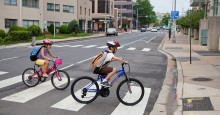
Driving reminders for school zone safety
Students going back to school have an impact on safe driving in September as drivers slow down, stop suddenly or make quick turns as they enter school zones.
Even a quick glance to answer a cell phone or view a GPS map can lead to disaster. Children excited about returning to class don’t always look for approaching vehicles as they chase after friends or cross the street without looking when getting off a school bus.
Students riding bicycles also pose a potential hazard. As bicycles vie with other vehicles for space, children maneuver their bikes in and out of traffic.
According to The National Highway Traffic Safety Administration, most accidents occur on roads near where you live. About 52% of nonfatal accidents happen within five miles of the driver's residence, and some 77% occur within 15 miles of the driver's home.
September safety reminders for young drivers
- Be a defensive driver. Don’t react to drivers who pull in front of you or act aggressively. Take a few moments to avoid potential accidents.
- Road signs and cone zones. Look for temporary road signs that may indicate changes along the route you normally drive. Often, traffic fines are increased for speeding infractions in cone zones.
- School is now back in session. Take extra precaution for pedestrians and other drivers, who may stop suddenly or in unusual locations. Look for traffic coordinators in the mornings before school and afternoons when the school day has ended.
- Don’t drive drowsy. Take heed of warning labels on the medications that say it may cause drowsiness. Or, If you have had a few late nights helping your child with homework or finishing an extra project at the office, ask yourself if you may be too drowsy and distracted to get behind the wheel.
- Watch for motorcyclists and lane splitting. Even though temperatures are cooler in September, motorcyclists continue to share the road with you especially in warmer climates.
- Be aware of commercial vehicles. Truck drivers have difficulty seeing passenger vehicles which pull up alongside them. Avoid sudden stops or lane changes.
- Look for activity on cross streets. A rolling stop may place your vehicle into oncoming traffic, especially if your view is restricted by an overgrown bush or a slight hill.
- Always buckle your seat belts. Even if you are just going down the street or a block away to get groceries, most auto accidents occur within a five-mile radius of your home.
- Keep an eye out for critters. Animals are on the move in early autumn and at dusk, especially deer migrating from higher altitudes. Be alert for movement along the roadside and be prepared to slow down if necessary.
- Watch out for wet leaves. As leaves fall and cover the roads, they can become extremely slippery, especially when wet. Treat wet leaves like icy patches and exercise caution when driving over them. Reduce your speed and avoid sudden braking or turning, which can lead to loss of control. Drive with increased following distance to allow ample time to react to sudden stops.
- Be cautious in low sunlight conditions. As the sun sits lower in the sky during autumn, it can create glare that impairs your vision while driving. Invest in a good pair of sunglasses to reduce glare, and use your vehicle's sun visor when needed. Be extra cautious as days grow shorter and glare becomes a driving challenge.
September safety tips for student cyclists and pedestrians

School zones pose additional hazards in fall.

Crosswalk activity increases in autumn.
Student cyclist tips
- Make sure your student cyclists know traffic safety rules such as riding in the same direction as traffic as well as obeying signs and signals.
- Make sure your children have acquired the skills to ride their bicycles and electric bicycles safely–such as riding in a straight line and signaling to vehicles when turning. That also is true for motorized skateboards and scooters.
- Talk to your kids about the safest bike route to school. If there are protected bike paths, use them. Otherwise, look for routes that have fewer cars and reduced speed limits.
- Teach children why wearing a helmet is important. According to the Insurance Institute of Highway Safety, wearing a helmet can reduce the odds of head injury by half.
- Students need to be reminded about being focused and alert when riding. Talk to them about not using earbuds or electronics while traveling. They need to see and hear the sounds of their surroundings.
Student pedestrian tips
- Accompany your student pedestrians to and from school if they are under 10 years of age. Teach them the importance of using crosswalks as well as looking both directions before crossing a road.
- Remind children to keep their eyes on traffic and not text while walking. Accidents can occur quickly from inattention, just as they do for people who text and drive.
- Use sidewalks whenever possible to prevent vehicle accidents. If there isn’t a sidewalk, make sure to walk facing traffic and be aware of what vehicle traffic is doing.
- If you are dropping kids off at school, choose a location that does not require them to cross a road. Encourage your youngsters to have a clear view of traffic and avoid entering streets from between parked cars.
Sources: National Highway Traffic Safety Administration, AAA insurance, National Safety Council
Copyright © 2024 by Sensible Driver. All rights reserved.